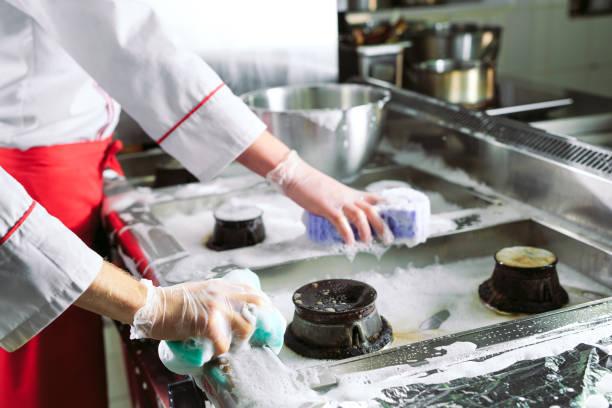The Complete Guide to Grease Trap Cleaning in Commercial Kitchens

Maintaining a clean and efficient commercial kitchen goes beyond wiping down counters and floors. One of the most overlooked yet essential tasks is grease trap cleaning—crucial for hygiene, safety, and keeping plumbing systems running smoothly. Grease, fats, and oils can quickly build up, leading to clogs, unpleasant odors, and even costly shutdowns if not addressed regularly. A proper grease trap cleaning routine not only prevents these issues but also keeps your staff and customers safe while ensuring compliance with health codes. And remember—when it comes to kitchen cleanliness, staying on top of it is always the way to go.
If you operate in Hanahan, SC, SoftWash Pros offers specialized commercial cleaning services tailored to restaurant kitchens, ensuring compliance and spotless results.
What Is a Grease Trap and Why It Matters
A grease trap is a plumbing device that intercepts fats, oils, and grease (FOG) before they enter the wastewater system. Without it, FOG can accumulate in pipes and cause blockages, leading to expensive plumbing repairs and environmental violations. Proper grease trap cleaning is a key part of any kitchen cleaning routine and is required by most health departments to stay compliant.
How Grease Traps Work
Grease traps slow down the flow of wastewater, allowing FOG to separate and float to the top while solids settle at the bottom. The cleaner water exits through a separate outlet. Over time, both grease and solids build up and must be manually removed. Failing to do so can cause backups and create a serious sanitation hazard.
Signs Your Grease Trap Needs Cleaning
Not sure if it’s time for a clean-out? Watch for these signs:
-
Slow-draining sinks and dishwashers
-
Persistent kitchen odors
-
Grease pooling around drains
-
Grease trap overflows or backups
-
Unusual noises in the plumbing system
If your kitchen experiences any of these, immediate grease trap cleaning is necessary to prevent further damage.
How Often Should You Clean a Grease Trap?
Frequency depends on your kitchen’s volume. A general rule is:
-
Every 1–3 months for busy commercial kitchens
-
Monthly for mid-size restaurants or food trucks
-
Bi-weekly for high-volume fry kitchens
Some local regulations may mandate specific schedules, so be sure to check with local health authorities. Consistency is critical to staying compliant and maintaining proper kitchen cleaning standards.
Step-by-Step Grease Trap Cleaning Process
While many restaurants hire professionals for this task, understanding the process helps in overseeing the job:
-
Turn off the water and allow the system to cool
-
Open the grease trap lid carefully
-
Remove accumulated grease and solid waste using a scoop or vacuum
-
Clean the interior using non-toxic degreasers and brushes
-
Rinse thoroughly and inspect for damage
-
Reassemble the trap and restore water flow
Always dispose of grease waste properly in accordance with local regulations.
What’s the best way to clean a grease trap in a commercial kitchen?
The best way to clean a grease trap in a commercial kitchen is by performing routine manual removal of fats, oils, and grease, followed by thorough scrubbing using food-safe degreasers. Regular maintenance every 1 to 3 months helps prevent clogs, odors, and health violations. Hiring professional services ensures compliance and long-term system performance.
Benefits of Regular Grease Trap Cleaning
-
Prevents costly plumbing issues
-
Improves overall kitchen hygiene
-
Reduces foul odors
-
Ensures compliance with health and safety codes
-
Protects your reputation with inspectors and customers
Kitchen cleaning routines that skip grease trap maintenance risk sudden service interruptions and long-term damage.
Mistakes to Avoid
-
Ignoring cleaning schedules
-
Using harsh chemicals that corrode the trap
-
Allowing untrained staff to clean improperly
-
Disposing of grease waste down the drain
-
Failing to maintain records of cleanings for compliance
Avoiding these common errors keeps your kitchen running smoothly and safely.
The Role of Professional Cleaning Services
While daily kitchen cleaning tasks can be managed in-house, grease trap cleaning often benefits from professional handling. Companies like SC SoftWash Pros specialize in commercial kitchen cleaning services, including grease trap maintenance, exhaust hood system cleaning, and vent filter care. Professional teams bring efficiency, compliance knowledge, and proper disposal practices to the job.
Conclusion
Grease trap cleaning is a crucial but often underappreciated part of maintaining a clean and functional commercial kitchen. When done regularly and correctly, it prevents odors, blockages, and costly repairs, ensuring your kitchen runs efficiently and safely. By including this in your broader kitchen cleaning checklist, you protect your team, your equipment, and your business reputation.
FAQs (with keyword usage)
1. Why is grease trap cleaning important for kitchen cleaning?
It prevents drain clogs, foul odors, and ensures a hygienic environment, making it a vital part of any kitchen cleaning routine.
2. How often do commercial kitchens need grease trap cleaning?
Most need it every 1 to 3 months, depending on volume, to remain compliant with health and safety standards.
3. Can I perform grease trap cleaning myself?
Yes, but it's often best handled by professionals to ensure thorough removal, proper disposal, and code compliance.
4. What happens if you skip grease trap cleaning?
Expect clogs, foul smells, potential fines, and even kitchen shutdowns. It’s not worth the risk.
5. Does SC SoftWash Pros offer grease trap cleaning?
Yes, SC SoftWash Pros provides expert grease trap cleaning as part of their full-service commercial kitchen cleaning solutions in South Carolina.
- Art
- Causes
- Best Offers
- Crafts
- Dance
- Drinks
- Film
- Fitness
- Food
- Spiele
- Festival
- Gardening
- Health
- Startseite
- Literature
- Music
- Networking
- Andere
- Party
- Religion
- Shopping
- Sports
- Theater
- Wellness



